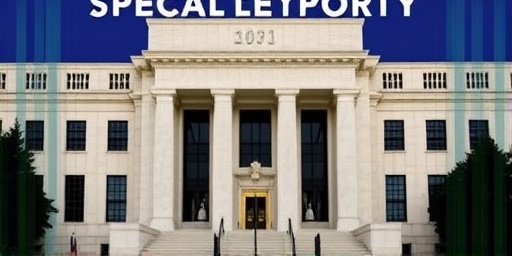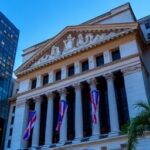In a pivotal moment for the U.S. economy, Federal Reserve Chair Jerome Powell delivered testimony before Congress that has markets buzzing with anticipation for a potential rate cut as early as December. Citing a cooling job market and moderating inflation pressures, Powell’s remarks suggest the Fed may soon pivot from its aggressive hiking cycle, offering relief to borrowers and businesses strained by elevated interest rates. This hint comes amid softer employment data, including a recent jobs report showing nonfarm payrolls rising by just 187,000 in November—below economist expectations—and the unemployment rate ticking up to 3.7%.
- Powell’s Testimony Spotlights Cooling Jobs Data and Fed‘s Evolving Stance
- Markets Rally on Rate Cut Hopes: Treasury Yields Plunge Amid Investor Optimism
- Underlying Economic Pressures: How Softening Jobs Data Shapes Fed’s Rate Cut Calculus
- Expert Views: Economists and Analysts Debate Timing and Magnitude of Fed Rate Cuts
- Future Outlook: What a December Rate Cut Means for Consumers, Businesses, and Global Markets
Powell’s Testimony Spotlights Cooling Jobs Data and Fed‘s Evolving Stance
During his semi-annual testimony before the House Financial Services Committee, Jerome Powell emphasized the Fed‘s dual mandate of maximum employment and price stability, noting that recent indicators point to a labor market losing some steam. ‘The job market remains solid, but it’s cooling from the blistering pace we’ve seen,’ Powell stated, highlighting how wage growth has decelerated to 4.1% year-over-year, down from peaks above 5% earlier this year. This softening, he argued, reduces the risk of wage-price spirals that could reignite inflation.
Powell’s comments were measured yet optimistic, avoiding firm commitments but opening the door to a rate cut. He referenced the Fed‘s benchmark federal funds rate, currently at 5.25% to 5.50%—the highest in over two decades—as potentially overkill if economic data continues to moderate. ‘We are well positioned to respond to incoming information,’ Powell said, a phrase that Wall Street interpreted as code for imminent easing. This testimony builds on the Fed‘s September meeting minutes, where officials debated the timing of rate reductions, with some projecting cuts as early as the fourth quarter of 2023.
The context of Powell’s remarks is crucial: The U.S. economy has defied recession fears, with GDP growth clocking in at 2.8% annualized in the third quarter. However, persistent interest rates have squeezed consumers, particularly in housing and auto sectors, where mortgage rates hover around 7.5% and car loan rates exceed 8%. Powell’s nod to a potential December adjustment signals the Fed is closely monitoring jobs reports, with the next one due in early December potentially tipping the scales.
Markets Rally on Rate Cut Hopes: Treasury Yields Plunge Amid Investor Optimism
Financial markets wasted no time reacting to Powell’s testimony, with a clear bullish tilt toward expectations of a rate cut. The 10-year Treasury yield, a benchmark for long-term interest rates, dipped below 4.2% immediately following the speech—the lowest in weeks—and closed the day down 0.15 percentage points. Stock markets followed suit, as the S&P 500 climbed 1.2%, buoyed by gains in rate-sensitive sectors like technology and real estate.
Investors are pricing in a 70% probability of a 25-basis-point rate cut at the Fed‘s December 12-13 meeting, up from just 50% a week prior, according to CME FedWatch Tool data. ‘Powell’s dovish tone has shifted the narrative from ‘higher for longer’ to ‘easing soon’,’ said economist Lydia Chen of Capital Economics in a note to clients. Bond traders, meanwhile, are snapping up Treasuries, driving yields lower and signaling bets on sustained disinflation.
This market response underscores the sensitivity of asset prices to Fed signals. Since the hiking cycle began in March 2022, the Fed has raised rates by 525 basis points to combat inflation that peaked at 9.1%. Now, with core PCE inflation at 2.7%—nearing the 2% target—traders see room for relief. However, volatility persists; a hotter-than-expected jobs report could reverse these gains, reminding investors that Powell’s path remains data-dependent.
- S&P 500: +1.2% post-testimony
- 10-Year Treasury Yield: Fell to 4.18%
- Fed Funds Futures: Imply 75% chance of December cut
Beyond equities, the dollar weakened against major currencies, dropping 0.8% versus the euro, as lower interest rates prospects diminish its appeal. Cryptocurrency markets also surged, with Bitcoin topping $38,000, reflecting broader risk-on sentiment.
Underlying Economic Pressures: How Softening Jobs Data Shapes Fed’s Rate Cut Calculus
The cooling job market is at the heart of the Fed‘s potential pivot. October’s employment report revealed hiring slowing to 150,000 jobs added, the weakest in months, with revisions shaving 91,000 from prior figures. Jerome Powell pointed to these trends in his testimony, noting that while unemployment remains low historically, sectors like manufacturing and retail are showing cracks. ‘Layoff announcements have ticked up, and job openings have fallen to 8.8 million from 11.5 million peaks,’ he observed, drawing from the latest JOLTS data.
This deceleration aligns with the Fed‘s goal of engineering a soft landing—curbing inflation without tipping into recession. Consumer spending, which drives 70% of the economy, held steady at 2.2% growth in Q3, but high interest rates are curbing big-ticket purchases. Credit card delinquency rates have climbed to 3.5%, per the New York Fed, signaling household stress amid elevated borrowing costs.
Powell’s remarks also touched on global factors, including geopolitical tensions in the Middle East that could stoke energy prices and complicate the inflation fight. Yet, domestically, shelter costs—a stubborn component of CPI—have eased to 6.7% annual growth, providing the Fed with breathing room. Economists like those at Goldman Sachs now forecast three rate cuts in 2024, starting in December, projecting the federal funds rate to end the year at 4.75% to 5.00%.
In a broader context, the Fed‘s actions ripple through the financial system. Small businesses, per the NFIB survey, report financing as their top concern, with 12% citing high interest rates as a barrier to expansion. Powell acknowledged this, stating, ‘Our policies must balance supporting jobs growth with price stability—it’s a delicate dance.’
Expert Views: Economists and Analysts Debate Timing and Magnitude of Fed Rate Cuts
Reactions from economic experts highlight the nuanced debate around the Fed‘s next moves. ‘Powell’s testimony was a clear signal that the job market‘s cooldown is giving the committee confidence to cut rates without fearing a rebound in inflation,’ said Mark Zandi, chief economist at Moody’s Analytics. Zandi predicts a December rate cut of 25 basis points, followed by two more in 2024, as interest rates normalization takes hold.
Not all views are unanimous. Some analysts, like those at JPMorgan, caution that sticky services inflation—running at 5.1%—could delay action. ‘The Fed under Powell has been burned by premature easing before; expect them to wait for more evidence,’ warned senior strategist Michael Feroli. A Reuters poll of 80 economists showed 65% anticipating a December move, but with variance on the size: 20 basis points versus the standard quarter-point.
From a policy perspective, the Fed‘s dot plot from September indicated most officials see rates falling to 4.4% by year-end 2024. Powell reiterated this forward guidance, emphasizing data over dogma. International observers, including ECB President Christine Lagarde, have noted parallels, as Europe’s central bank also eyes cuts amid similar jobs softening.
- Key Data Points: Unemployment at 3.7%, wage growth slowing
- Expert Consensus: 70% chance of December cut
- Risks: Geopolitical flares or hot inflation data
Wall Street heavyweights like BlackRock’s Rick Rieder see the rate cut path boosting corporate earnings, with S&P 500 profits potentially rising 12% in 2024 on cheaper borrowing.
Future Outlook: What a December Rate Cut Means for Consumers, Businesses, and Global Markets
As the Fed contemplates a rate cut, the implications extend far beyond Wall Street. For everyday Americans, lower interest rates could ease mortgage burdens, with the average 30-year fixed rate potentially dropping to 6.5% by mid-2024, per Fannie Mae forecasts. Homebuilders, battered by high rates, stand to benefit, as housing starts—currently at 1.4 million annualized—could rebound 10-15%.
Businesses, particularly in capital-intensive industries, would welcome cheaper financing. The job market, while cooling, is expected to stabilize, with payroll growth settling at 125,000-150,000 monthly, avoiding mass layoffs. Jerome Powell stressed vigilance, warning that the Fed would pause if inflation reaccelerates.
Globally, a U.S. rate cut could pressure emerging markets, as capital flows shift toward higher-yield destinations. Yet, it might synchronize with easing from the Bank of England and ECB, fostering a softer landing worldwide. Looking ahead, the December FOMC meeting will be pivotal; markets await not just the decision but Powell’s press conference for further clues on the Fed‘s trajectory through 2024.
In this data-driven environment, the Fed‘s next steps hinge on upcoming releases like the November CPI, due December 12, and the jobs report on December 7. If trends hold, a rate cut could mark the beginning of a new chapter, balancing jobs preservation with inflation control and setting the stage for sustained economic expansion.









